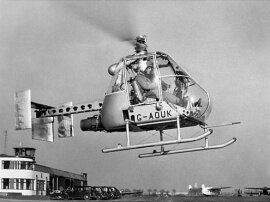|
Elfan ap Rees, founder and current chairman of The Helicopter Museum, became aware of an opportunity to acquire the aircraft which was duly transported to Weston-super-Mare in May 1979, where it was put into temporary storage to await restoration. Rotor blades, an engine and an instrument panel were later obtained from Cranfield and elsewhere but no rotorhead could be found then or since.
By 1991 G-AOUJ had been partially re-assembled by Museum volunteers, although it still lacked a rotorhead. Partly due to a heavy workload and shortage of covered space at The Museum, the Ultra Light was loaned to the Cotswold Aircraft Restoration Group, in Gloucestershire, so that restoration could continue there. Some valuable work was being done until closure of RAF Innsworth was announced and CARG's workshop had to be re-located to Quedgeley in 2002. After another enforced move in 2007, Peter Turner, a Helicopter Museum trustee, offered suitable temporary hangar storage for G-AOUJ, at Gloucestershire Airport, until it was returned to Weston-super-Mare in November 2010. |
||
| Fairey Ultra-Light, G-AOUJ, soon after arriving at The Helicopter Museum on 3rd November 2010. | ||
 |
The Ultra-Light was a compact, side-by-side, two-seater helicopter with an enclosed cockpit mounted on a strong alloy box which contained the fuel tank bag. The two crew seats, with pilot on the right and observer (optionally facing aft) on the left, were fixed on top of the box. Also attached to the box was a rectangular-section tail boom which supported a Blackburn-Turbomeca Palouste turbine, with oversized compressor, behind the seats. Further to the rear a central rudder was positioned in the turbine efflux, for yaw control. A horizontal tailplane with endplate fins (see left) was added to later versions. A pair of skids were attached to tubes across the underside of the box. The Palouste compressor fed air through ducts to the blade ends where fuel was injected and the mixture ignited before being directed to the blade tip jets. |
|
| Fairey Ultra-Light, G-AOUK / XJ924, was shown at Farnborough in 1956 and continued to be used afterwards, primarily, as a demonstrator. | Cockpit controls were orthodox with a collective pitch lever for adjusting engine revolutions, hence tip jet pressure, and a cyclic stick for roll and pitch control. | |